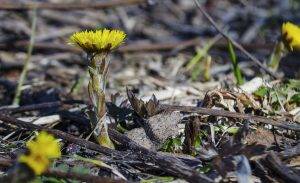
Martilapu- Tussilago Farfara L.
Description of Martilapu:
Tussilago Farfara L. (Old or other known names: horsetail grass, wolf’s-foot grass, little sweet bladderwort, marigold, stepmother’s blade, ass’s-foot, donkey’s-foot, bastard, hen’s-foot) Nests – Compositae The marigold has a stalk, called a rhizome, which extends underground and produces many short lateral branches or tendrils. These short tendrils also remain in the ground, are pale reddish in colour, covered with tiny scales and have a cluster of 5 to 8 leaves above the ground, which, however, only appear after flowering. The short lateral branches, hidden in the ground, sprout and in the following spring a flower head emerges from the axils of last year’s leaves. Since they are close together, the flower heads always appear in groups. The underground stem is yellowish-brown, rosy, sometimes violet-brown and 4-6 mm thick. It produces simple, fibrous roots. The stalk, which has sprouted in the ground, develops flowering stems in early spring, as early as February-March. The flower heads emerge from a stalk from 4 to 20. Each stem has a single flower head at the top and neither branches off nor bears green leaves, but only vestigial brown scales. These scales are lance-shaped, reddish brown in colour and blend in with the stem. The stem is woolly-haired and only 6-10 cm tall at first, but after flowering it can grow to 20-30 cm. The flower head at the top of the stem is made up of a cluster of densely packed, tiny yellow flowers. The flower head opens only in bright light and closes when exposed to sunlight. The head is surrounded by a collar of rounded stalked leaflets. The flowers are yellow. After flowering, or towards the end of flowering, the leaves of the marigold appear. The flowers produce small heads with white feathery hairs on top. These small furry fruits are easily picked up by the wind and carried away. After flowering, or towards the end of flowering, the leaves of the martilap appear. The leaves are 5-7 in clusters on a common short stem. Leaves elongate, angular, cordate, with unevenly lacy margins; glabrous and dark green above, the phlox white fuzzy. The petioles are often violet-coloured, up to 10 cm long, and furrowed on the upper side. The leaf blade can reach the same length. The shape of the leaf is similar to the perimeter of a horse’s paw, except that it is angled and has a toothed edge. It flowers normally in March, often as early as February, but can also be found in flower in early April. Its leaves are found from April onwards.
 Occurrence:
Occurrence:
Martilapu grows on clay and calcareous soils. It grows in clay, clayey soil, clayey clay, clayey soil, clayey soil, clay and clayey soil. On railway embankments, barren mountain sides and the slopes of fresh hillsides, the martilapu quickly colonises, the wind carrying its blossoming fruits and melves to the ground where they hatch. In the fields of the whole country, martilap grows, and in many places in the fields it is a noxious weed. On clayey, moist soils, especially on the continents of the northern temperate zone.
Medicinal properties and uses of martilap:
In medicine, the leaves of martilapu are used under the names folia farfarae and herba farfarae. Both the leaves and the flowers and root contain many bitter substances, as well as mucilaginous and tannic substances. Martlapu tea is a good remedy for cough and hoarseness, long-lasting bronchitis and mucus, and gives relief to those with lung disease. Its freshly squeezed juice is used to cure croupy boils. Its flowers are also harvested and sold under the name flares farfarae, but more for domestic use. Its dried leaves are also mixed with tobacco, and its fresh leaves are eaten in Transylvania in spring as a stew, and are therefore a regular market staple in spring.
Active ingredient:
 Dextrin, mucilage, essential oil and tanning agent.
Dextrin, mucilage, essential oil and tanning agent.
Harvesting:
The martilapu leaves are harvested in June or July. When picking the leaves, as they are no longer in flower, care should be taken not to confuse them with the leaves of the hat-grass(Petasites offcinalis), which differ from the hat-grass mainly in that the leaves are much larger (30-60 cm), more kidney-shaped and their backs are not white fuzzy but ashy, later becoming glabrous. Its flowers should be picked in March and dried in a place protected from the sun (attic). Only the leaves should be picked for trade. The leaves are spread out in a thin layer in the attic and dried. The dried leaves are then bagged for transport. 5 kg of fresh leaves will yield 1 kg of dry leaves. Source: Dr. Ferenc Darvas and Dr Gyula Magyary-Kossa,Domestic herbs, their production, marketing, effects and medicinal uses Béla Páter, Wild medicinal plants, their production, use, distribution, and marketing
